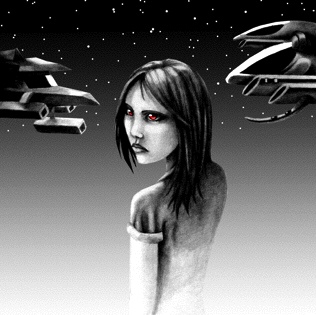Martin Kerharo, Dohani : Guerre
reviewed by Don Webb

Dohani : Guerre (‘The Dohani: War’) writing as Marty Kero Publisher: Lulu, November 2009 Trade paper: 233 pp. Language: French ISBN: 978-1-4452-3591-2 |
It’s quite clear who Jane is. She’s a girl taken as a prisoner of war by Lt. Dexter Zimski’s commando squad in a raid on a Dohani space station. The real question soon becomes obvious and urgent: What is Jane?
About three or four centuries in the future, a federation of colony planets governed by Earth is at war with a mysterious race known as the Dohani. The cause of the war is obscure, and while its scope has so far been limited to border skirmishes, the threat of an all-out attack by one side or the other always lurks in the background.
The Dohani are insect-like beings a little taller than humans on average, with four red eyes. Military intelligence has taken some Dohani prisoners and acquired many samples of Dohani writing, but the script is indecipherable; in fact, no one can determine how the Dohani communicate among themselves other than by writing. Jane is given the name “Jane Doe” by default.
What, then, is Jane? Her eyes are red like those of the Dohani, but otherwise she appears to be a normal human girl of about sixteen. Was she a human prisoner of the Dohani or is she a spy? However, Jane is human only in appearance. She’s strong and skilled in martial arts. Nothing prevents her from speaking, but she seems to have no concept of language as oral speech.
From the first, Jane is smitten with a coup de foudre, an unaccountable emotional attachment to Dexter Zimski. Jane’s inexplicable choice is a wise one: Zimski is fond of her and very protective. He tries patiently to establish some kind — any kind — of communication.
At the risk of injecting a spoiler: Jane’s nature gradually becomes clear. The Dohani are as baffled by humanity as humanity is by the Dohani; Jane is a native-born Dohani, but she has been genetically modified and enhanced in the hope she might be able to function as an intelligence agent in human territory. She succeeds beyond her planners’ wildest dreams.
Jane’s attachment to Dexter Zimski — to whom she cannot speak — seems very strange to Dexter himself, but he eventually learns that what is outlandish in one star system may be perfectly normal in another. However, that is not where the story ends: both Jane and Dexter grow beyond their initial roles and become de facto ambassadors — and more.
The opening scenes and some elements of the plot recall Joe Haldeman’s classic novel The Forever War. But there the simiilarity ends. Haldeman updated Eric Maria Remarque’s All Quiet on the Western Front with an allegory of the Vietnam War and ends it in bitter irony. In contrast, Dohani : Guerre centers on achieving communication in seemingly impossible circumstances and, beyond that, on establishing interspecies trust. Jane and Dexter show that it can be found when neither is a prisoner of the other.
In some ways, Dohani : Guerre is a mirror image of Michael E. Lloyd’s Observation trilogy, in which the space-alien Domans come to Earth to trade for raw materials. They remain in Earth orbit but visit the surface by means of virtual avatars. They are eager tourists as well as astute business-beings. The Domans readily understand Earth’s culture and draw ironic conclusions about Earthlings’ capacity for self-deception. Communication is no problem at all for the Domans: they use telepathy, and their mastermind, Quo, is loquacious and engages freely in mind control.
The Dohani are, like the Domans, peaceful by nature, and they also communicate among themselves by means of telepathy. But the similarity ends there. The Dohani are ready to use military force when and if they feel the need to. They are very advanced in the biological sciences, but their knowledge is of little avail in learning to communicate with humans. The Dohani have a real, not a virtual presence, but they are not observers; human communication and culture are as opaque to the Dohani as Dohani writing is to their human counterparts.
The Dohani, like Jane, and the humans, like Dexter Zimski, are thus depicted as real people struggling on a more or less equal footing to overcome suspicion and to understand the inexplicable lest it destroy them. The obvious a fortiori moral is left unstated.
Unlike the Observation trilogy, Dohani : Guerre is a morality play for young adult readers of about Jane’s age. It does not provide role models so much as illustrate the attitudes needed to solve problems in interpersonal and intercultural relationships. In the end, the Observation novels and Dohani : Guerre bring, in their own very different ways, a sense of optimism and a breath of fresh air to the science fiction of today.
In Dohani : Guerre the author has kept his young adult audience constantly in mind. The novel has a wealth of reader interest: action, intrigue, science, and a love story of unusual realism. The human characters are of no particular nationality. Anglophone high-school students in advanced French classes will find the language quite accessible provided they know how to read for context.
Copyright © 2010 by Don Webb

